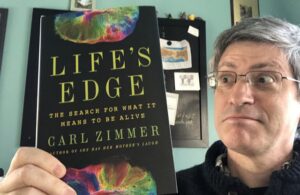It’s been ten days since the publication of Life’s Edge. For the past couple weeks, I’ve taken a break from covering the pandemic for the New York Times to work on the book launch. Here are a few highlights so far: Continue reading “Friday’s Elk, March 19, 2021”
Category: Newsletter
I don’t know what it’s like for you, but this March is giving me some hesitant hope. Maybe this has something to do with it:

There are four days left before the book comes out, but today–with a hard copy to clutch–feels like the day the book comes alive (forgive the pun).
This is a quick note to draw your attention to a piece I’ve just published that I’m very proud to share. Tomorrow’s Sunday Review in the New York Times features a long essay I adapted from my new book Life’s Edge. It’s called “The Secret Life of a Coronavirus.”
In my essay, I touch on a couple of the big questions in my book: what does it take to be alive, and what are we to make of the things that don’t quite meet our requirements? Our current pandemic is the work of one such hard case. Continue reading “Friday’s Elk, February 27, 2021”
Life Finding A Way
On a snowy February afternoon almost exactly a year ago, I took my final pre-pandemic road trip. I drove to Albany, where I met a pair of wildlife biologists named Carl Herzog and Katelyn Ritzko. Together we traveled on into the Adirondacks, stopping at the end of a road in the woods. Getting out of the car, we hiked a snow-covered trail until we reached a half-frozen stream. There we stopped to suit up in neoprene chest waders. We put on helmets, switched on headlamps, and stepped into the stream to make our way into a flooded graphite mine.
“Tripping and falling is the biggest threat,” Herzog said as the darkness closed around us. “You don’t ever want to touch the ceiling.”

We’re getting down to the one-month-left mark before my new book comes out on March 9. It’s called Life’s Edge: The Search for What It Means To Be Alive.
The book is a travelogue across the familiar territory of life as we know it into the strange borderlands between the living and the non-living. It features a huge cast of characters, including slime molds that solve mazes, hibernating bats deep in graphite mines, hungry pythons, tardigrades abandoned on the moon, and the enigma that is Covid-19. Publisher’s Weekly calls Life’s Edge “a pop science tour de force.”
Goodreads is running a giveaway for Life’s Edge this month. Visit this page by March 1 and click the “Enter Giveaway” button for a chance to win one of fifteen finished hardcovers. (Only U.S. residents are eligible, I’m afraid.)
I’ll have more updates on radio appearances and other events for LIfe’s Edge that I’ll share in upcoming newsletters. In the meantime, you can pre-order it here.
The Vexing Variants
A year ago, we were just getting to know a single strain of coronaviruses, SARS-CoV-2. Now its evolutionary tree has branched into thousands of lineages of variants. A few of them are now posing daunting challenges to the world’s efforts to get ahead of the pandemic. I spent a lot of the past month trying to keep up with this astonishing episode of evolution in action.
The variant that we know best was first found in England. Nicknamed “the UK variant” or the “Kent strain” by some, it officially goes by the name B.1.1.7. Jonathan Corum and I took it apart (visually at least) to show what we know about how its mutations turned it into a fast-spreading version of the coronavirus.
B.1.1.7 is still mutating, and scientists are worried that it may gain new mutations that will make it not only more contagious, but harder to control. In England, scientists have found samples of B.1.1.7 that have gained a new mutation that experiments suggest could make it harder to rein in with vaccines or treat with monoclonal antibodies.
It’s difficult to tell right away just how dangerous these new variants are. In California, for example, one lineage of coronaviruses has swiftly become more common in places like Los Angeles. Scientists are still figuring out if it has some biological features that makes it more contagious, rather than just getting spread more by chance. I’m keeping an eye on this variant, known as B.1.429, and will let you know if it’s a variant of serious concern.
Unfortunately, as these mutants zoom across the world, the United States and many other countries are not well-equipped to track them. We don’t have a federal mandate or a nationally organized system for getting coronavirus samples quickly sequenced and analyzed. We’re flying blind into a storm of variants. Fortunately, the new director of the CDC is ramping up more sequencing, but experts say we still need to do a better job.
Even as variants emerge, vaccines remain an essential weapon for fighting the pandemic. Experiments suggest that vaccines can work well against B.1.1.7. And Israel is offering some real-world support for that view. B.1.1.7 is already predominant there, but an aggressive vaccination campaign has led to marked declines in cases and hospitalizations among people over 60, the first group to get vaccinated.
But another variant first found in South Africa, called B.1.351, could prove more challenging. Johnson & Johnson and Novavax both found that the protection from their vaccines wasn’t quite as strong in South African trials than elsewhere.
It’s important to stop and marvel at the fact that in about a year, vaccine designers have demonstrated that eight different vaccines can protect people against Covid-19. The efficacy of the vaccines varies enormously, from about 50 percent to 95. But they’re all vastly better than zero.
The blazing success that scientists have experienced over the past year can make us complacent about how hard it is to make a vaccine. Johnson & Johnson has demonstrated their vaccine has an efficacy rate of 72 percent in the United States and is widely expected to get emergency authorization by the end of February. But it’s not clear yet how many doses they’ll be able to deliver right after that–at a moment when the country is desperate for as many doses as it can get.
We should also offer a tip of the hat to Merck, which abandoned not one but two vaccines after early clinical trials delivered disappointing results in January. Along with the University of Queensland and Sanofi’s failed attempts, that comes to four abandoned vaccines on the path out of the pandemic.
As more and more vaccines start getting injected into millions of people each day, Jonathan Corum and I have created a set of illustrations to show how they work.
While vaccines have the potential to rein in the pandemic, we desperately need better drugs to stop infections early–and will continue to need them in the months to come. A year after the pandemic started, the race for a potent antiviral has proven frustrating compared to the success of vaccines.
On the front page of last Sunday’s paper, I explored why the two lines of research have turned out so differently. It’s hard to make a new drug from scratch, and it can also be challenging to test existing drugs to see if they can be repurposed for Covid-19. But the struggle has been hampered by a lack of organization, leading to lots of small trials that often fail to recruit patients and a paucity of big, well-designed trials that can settle once and for all whether potentially promising drugs actually work. But some new initiatives from NIH and the FDA could spur the development of potent new drugs and the start of potent trials for old ones.
It was kind of crazy to look at last week’s issues and see stories I had written or helped to write on the front page three days in a row. I will be quite happy to move deeper into the newspaper. That will be a sign that the pandemic is finally behind us all.

That’s all for now. Stay safe!
My next book is Life’s Edge: Searching for What It Means to Be Alive. It’s coming out in March 2021, but you can pre-order it now. You can find information and ordering links for my thirteen other books here. You can also follow me on Twitter, Facebook, Goodreads, and LinkedIn. If someone forwarded this email to you, you can subscribe to it here.
Best wishes, Carl
Originally published February 6, 2021. Copyright 2021 Carl Zimmer.